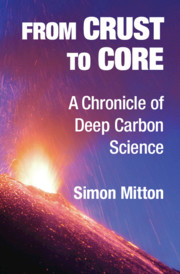Book contents
- From Crust to Core
- From Crust to Core
- Copyright page
- Dedication
- Contents
- Foreword
- Acknowledgments
- Introduction
- 1 Why Carbon in Earth Matters
- 2 The Origin of Deep Carbon in Deep Space
- 3 Deliveries of Cosmic Carbon Continue
- 4 On the Nature of Earth’s Interior
- 5 Earth’s Physical Interior Revealed
- 6 Thousands, Millions or Billions
- 7 Physics and Chemistry of Deep Earth
- 8 Confronting the Continental Drift Conundrum
- 9 The Mid-Atlantic Ridge and Rift Valley
- 10 Earth’s Deep Dynamics Discovered
- 11 Reversals of Fortune
- 12 Deep Carbon
- 13 Carbon-Bearing Phases in the Mantle
- 14 Diamond in the Mantle
- 15 Deep Life
- Glossary
- Biographical Notes
- Index
- References
12 - Deep Carbon
Cycles, Reservoirs and Fluxes
Published online by Cambridge University Press: 19 December 2020
- From Crust to Core
- From Crust to Core
- Copyright page
- Dedication
- Contents
- Foreword
- Acknowledgments
- Introduction
- 1 Why Carbon in Earth Matters
- 2 The Origin of Deep Carbon in Deep Space
- 3 Deliveries of Cosmic Carbon Continue
- 4 On the Nature of Earth’s Interior
- 5 Earth’s Physical Interior Revealed
- 6 Thousands, Millions or Billions
- 7 Physics and Chemistry of Deep Earth
- 8 Confronting the Continental Drift Conundrum
- 9 The Mid-Atlantic Ridge and Rift Valley
- 10 Earth’s Deep Dynamics Discovered
- 11 Reversals of Fortune
- 12 Deep Carbon
- 13 Carbon-Bearing Phases in the Mantle
- 14 Diamond in the Mantle
- 15 Deep Life
- Glossary
- Biographical Notes
- Index
- References
Summary
This chapter completes the story of the acceptance of plate tectonics, which marks the beginning of the modern period of Earth system science. This final approval required additional contributions by several researchers, with the key papers being published in 1968. Jason Morgan’s work on crustal blocks, of which he had given an impromptu preview at the American Geophysical Union in April 1967, proposed that on Earth’s dynamic surface 20 crustal blocks move relative to each other, endlessly jostling for their place in the jigsaw. Simultaneously, Xavier Le Pichon, a young French geophysicist who worked with the Ewing brothers at Lamont Geological Observatory from 1963 to 1989, connected the kinematic ideas of Morgan, McKenzie and Parker to the vast data sets held at Lamont, particularly the magnetic profiles. Le Pichon’s computer model demonstrated that the motion of six large rigid blocks completed a jigsaw that covered most of Earth and could accurately account for the evolution of ocean basins. His model of June 1968 indicated that plates do indeed form an integrated system in which the sum of all crust generated along 50,000 kilometres of ocean ridges equals the cumulative amount destroyed in the subduction zones.1
- Type
- Chapter
- Information
- From Crust to CoreA Chronicle of Deep Carbon Science, pp. 234 - 260Publisher: Cambridge University PressPrint publication year: 2020



